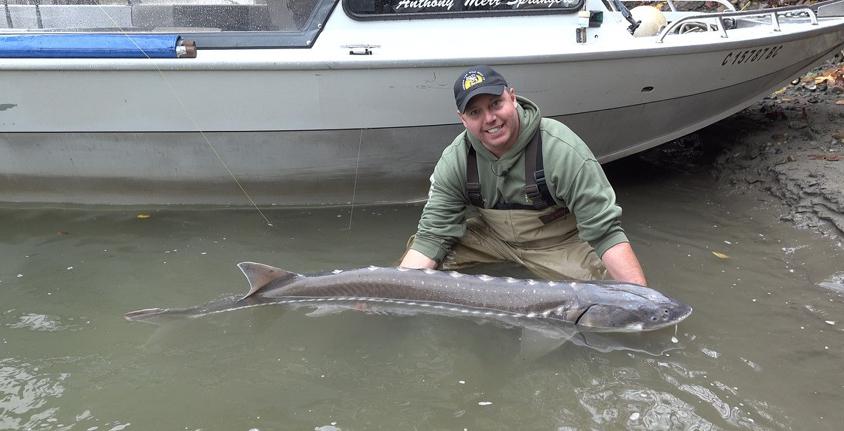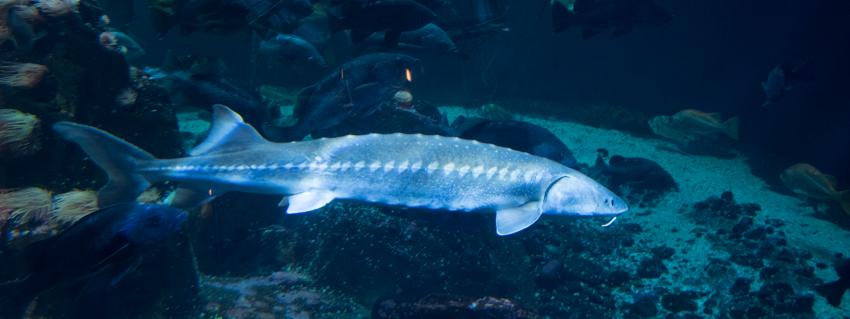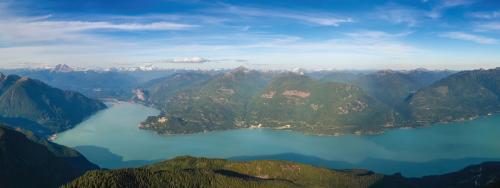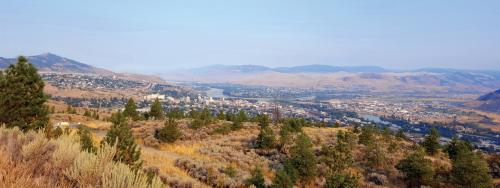“All of a sudden this monster came up out of the water and looked me in the eye,” John says. “I looked at my brother and said ‘I’m in.”
That monster was a white sturgeon, “the largest and longest-lived freshwater fish species in North America, with some individuals reported at over six metres in length and 100 years of age,” according to Fisheries and Oceans Canada.
These fish have been around since the age of the dinosaurs and have evolved very little over millions of years, while the world around them has changed at a rapid pace in the past couple of centuries and left their numbers dwindling dangerously low. In the late 1800’s and early 1900’s, white sturgeon were prized by commercial fishing operations on the Fraser River eager to meet the demand for sturgeon caviar.
Sturgeon are considered a threatened species and are protected, but there are poachers and other threats keeping these giant fish in peril, like development along the Fraser River and abandoned fishing nets in the river. The Fraser River Sturgeon Conservation Society (FRSCS) has been working to minimize these dangers through a combination of net-removal efforts, advocacy, education, research, and an award-winning volunteer-driven monitoring and assessment program.
In 2001, John joined the not-for-profit society and today he’s on the board of directors and is chair of the fundraising committee, which puts on the annual ‘Keeping the Legend Alive’ FRSCS Sturgeon Conservation Challenge Gala Awards Dinner & Auction event. Giving back to the communities where we live and work is important to FortisBC, and we saw a natural fit with the society’s conservation mission so we donated funds towards the event.
“Every bit of money helps,” John says. “We’re very excited to have FortisBC and other companies becoming champions for the species. It’s really nice for us, with FortisBC having an LNG plant in Delta, and them contributing funds to help the gala become a great success. The event raised just over $150,000 net.”
That money will help the society address sturgeon mortality, habitat erosion, monitoring and research into issues like juvenile sturgeon survival.
“We’re stewards for the fish, we work with First Nations, government agencies, other nonprofits and individuals… we collaborate and do everything we can to make sure the sturgeon has a voice,” John says. “We’re working to ensure the species is around for generations to come. This population of white wild sturgeon is last of its kind in the world… they’re just absolutely special, they’re individuals just like people. When I take people out on the river I take the time to point out how different each fish is.”

The society was founded in 1997 by legendary ‘Man in Motion’ Rick Hansen, who once journeyed through 34 countries on his wheelchair, raising money to find a cure for spinal cord injury while raising awareness about the potential of people with disabilities. A passionate fisherman, Rick advocated for a catch and release program that would allow other enthusiasts to enjoy fishing while providing a valuable service: tagging and recording details about each fish they catch, before carefully releasing them back into the water.

This monitoring program provides essential data for researchers tracking the health, age, migration patterns and population numbers of the sturgeon.
The society is hopeful that their efforts will help double the number of white sturgeon in the lower Fraser River, which they roughly estimate to be around 40,000 today. But since the fish take such a long time to mature and reach breeding age, it will take generations of committed volunteers and researchers to achieve this goal. Fortunately, from John’s experience, it just takes one encounter with this prehistoric fish for someone to become a passionate advocate for their survival.
“The most exciting thing is introducing people to them, people who’ve never seen them and all of a sudden a six or seven-foot fish jumps, you hear the ‘oohs’ and ‘aahhs’ and see their jaws dropping,” John says. “Sharing the experience is the most exciting thing, getting people to see how special the sturgeon are.”
Learn more, volunteer, or donate to the Fraser River Sturgeon Conservation Society.



